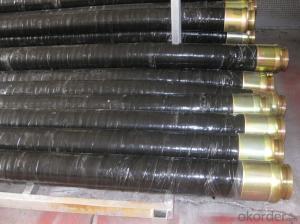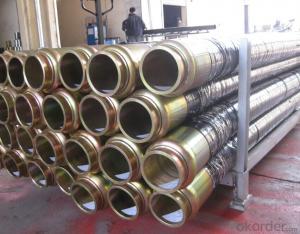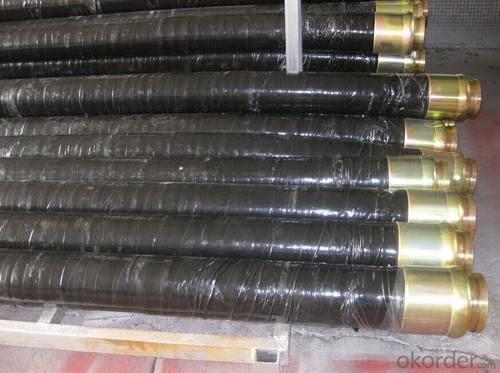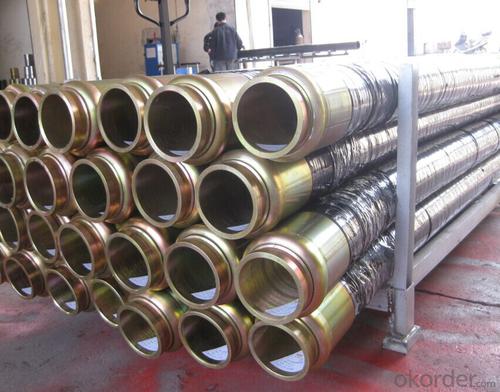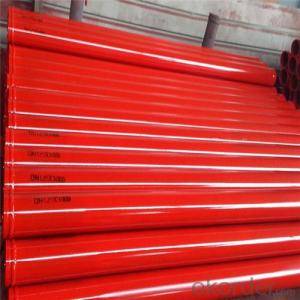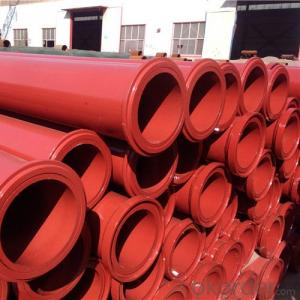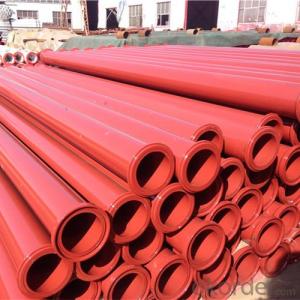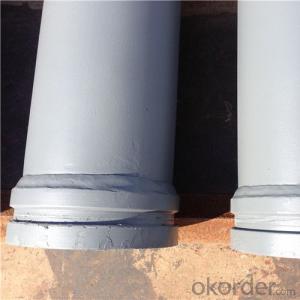6M*DN125(5.5'') RUBBER END HOSE WITH ONE SIDE COUPLINGS WORKING PRESSURE 85 BAR
- Loading Port:
- Shanghai
- Payment Terms:
- TT OR LC
- Min Order Qty:
- 10 pc
- Supply Capability:
- 5000 pc/month
OKorder Service Pledge
OKorder Financial Service
You Might Also Like
Specifications
Putzmeister concrete pump end rubber hose
1. Size: DN150, DN125, DN100, DN80...
2. Length: 1~9m
Concrete pump end rubber hose PM &Schwing
Name | Specifications | Application | Flange diameter | Remarks |
Rubber hose | DN125*3000 | Concrete pump | 148/DN157mm | |
Rubber hose | DN150*3000 | Concrete pump | 148/DN157mm | |
High pressure | DN125*3000 | Concrete pump | 148/DN157mm | Two layers of steel wire |
High pressure | DN125*3000 | Concrete pump | 148/DN157mm | Four layers of steel wire |
High pressure | DN125*4000 | Concrete pump | 148/DN157mm | |
High pressure | DN150*3000 | Concrete pump | 175mm | |
| DN80*5000 | Mortar pump mini conctete pump | 98mm | |
| DN80*6000 | Mortar pump mini conctete pump | 98mm | |
| DN100*5000 | Mortar pump mini conctete pump | 124mm | |
| DN76*6000 | Fine stone concrete pump mini conctete pump |
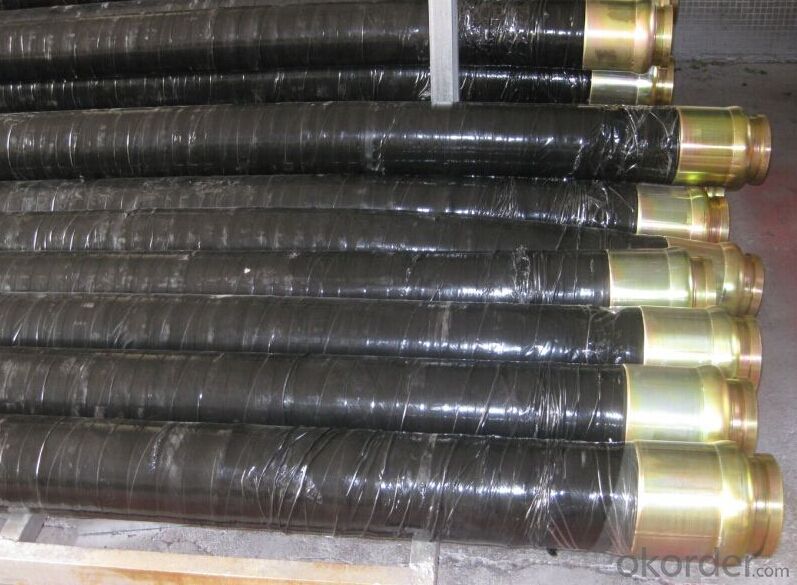
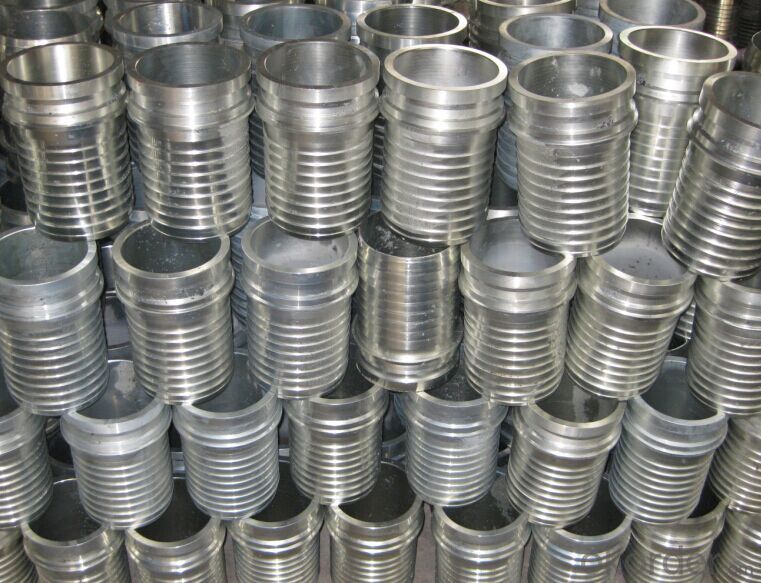
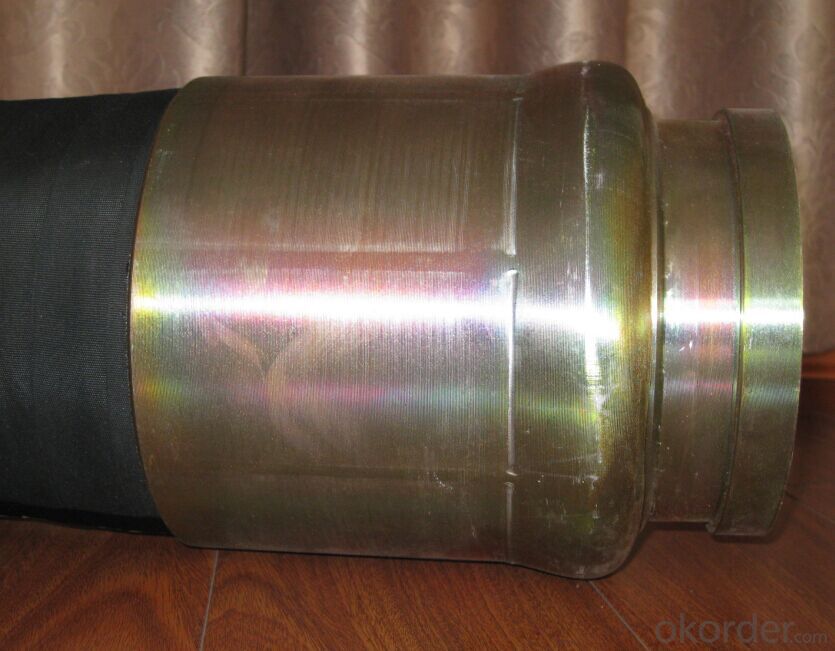
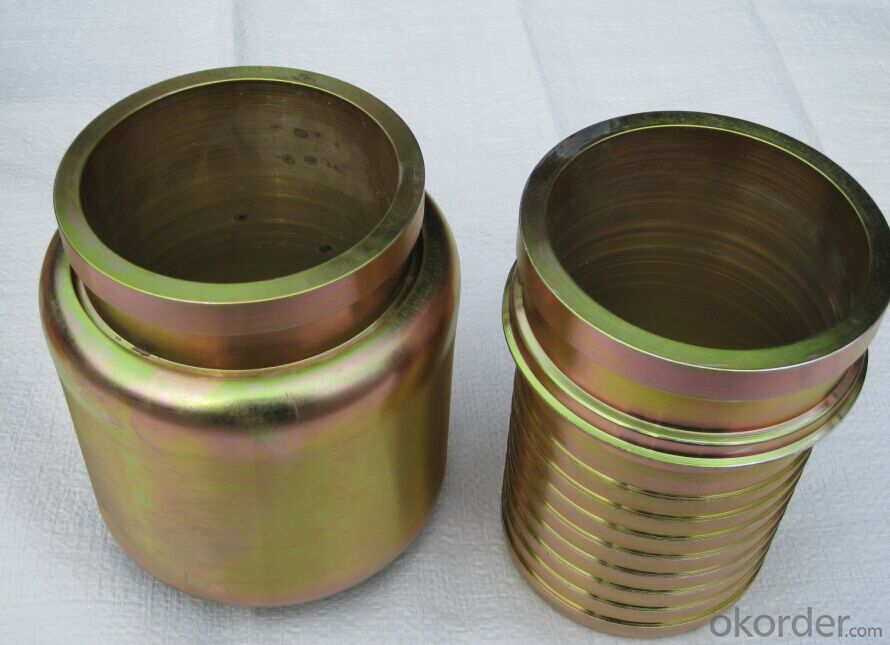
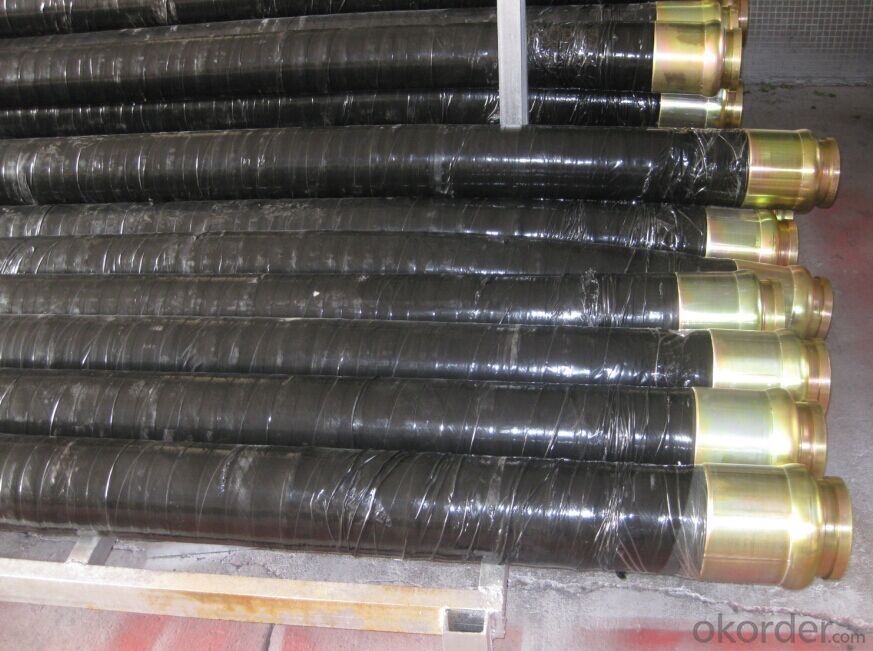
- Q: Are there any specific training or certifications required for handling and installing concrete pump spare parts?
- Handling and installing concrete pump spare parts necessitates specific training and certifications. Given the specialized nature of the equipment and the potential risks involved, individuals must undergo appropriate training and obtain relevant certifications. One must first acquire a comprehensive understanding of concrete pumps' functioning and components. This knowledge can be gained through extensive training programs offered by equipment manufacturers, industry associations, and vocational schools. These programs cover topics such as pump operation, maintenance, troubleshooting, and safety protocols. Furthermore, depending on jurisdiction or industry standards, specific certifications may be necessary. For instance, the American Concrete Pumping Association (ACPA) provides the ACPA Operator Certification, which requires individuals to demonstrate their proficiency in concrete pumping equipment, including the handling and installation of spare parts. Obtaining these certifications ensures that individuals possess the necessary knowledge and skills to handle and install concrete pump spare parts safely and efficiently. It also aids in complying with industry regulations and standards. It is crucial to note that the specific training and certification requirements may vary based on the region, industry, and type of concrete pump utilized. Therefore, it is advisable to consult local regulations and industry guidelines to ensure adherence to the requisite training and certification requirements for handling and installing concrete pump spare parts.
- Q: How often should concrete pump control panels be inspected and replaced?
- Concrete pump control panels should be inspected regularly, ideally on a monthly basis, to ensure they are functioning properly and to identify any potential issues. However, the frequency of replacement will depend on the specific condition of the control panel, as well as the manufacturer's recommendations. If any signs of wear or malfunction are detected during the inspection, it may be necessary to replace the control panel sooner.
- Q: Are there any maintenance tips to extend the lifespan of concrete pump spare parts?
- Concrete pump spare parts can have their lifespan extended by implementing several maintenance tips. Cleaning the spare parts regularly to remove dirt, debris, and concrete buildup is essential. This can be achieved by using a brush, water, and mild detergent. The cleaning process helps prevent corrosion and ensures smooth operation. Proper lubrication of the moving parts is crucial to reduce friction and wear. It is important to adhere to the manufacturer's recommendations for lubrication intervals and use high-quality lubricants. The lubrication points should be inspected regularly, and any worn-out or damaged lubrication components should be replaced. Regular inspections of all spare parts are necessary to identify any signs of wear, damage, or misalignment. Any issues that are identified should be promptly repaired or replaced. Moreover, following the maintenance schedule provided by the manufacturer is essential to address any potential problems before they escalate. When the spare parts are not in use, they should be stored in a clean and dry environment to prevent rust and corrosion. Protection from extreme temperatures, moisture, and direct sunlight is also important. Additionally, the spare parts should be stored in a way that prevents any damage or deformation. Using the concrete pump in accordance with the manufacturer's guidelines is crucial. Overloading, excessive pressure, or improper operation can lead to premature wear and damage to the spare parts. Proper training should be provided to the operators to ensure they understand the correct usage techniques. Furthermore, regular maintenance of the concrete pump itself is important. This includes cleaning, lubrication, and inspections. By addressing any potential issues, the lifespan of the spare parts can be prolonged. By adhering to these maintenance tips, the need for frequent replacements of concrete pump spare parts can be reduced, resulting in long-term cost savings.
- Q: How do I properly maintain and replace hydraulic hoses in concrete pump spare parts?
- Proper maintenance and replacement of hydraulic hoses in concrete pump spare parts involve a few essential steps. Firstly, it is crucial to regularly inspect the hoses for signs of wear, including cracks, leaks, or bulges. Any damaged hoses should be replaced immediately to avoid any potential accidents or disruptions in the pumping process. When replacing hydraulic hoses, it is essential to use high-quality hoses that are compatible with the concrete pump system. It is recommended to consult the manufacturer's guidelines or seek professional advice to ensure the correct specifications and fittings are used. During installation, make sure to properly clean and prepare the hose fittings and connections. This involves removing any debris or dirt that could cause contamination or hinder a secure connection. Additionally, it is essential to follow the recommended torque specifications when tightening the fittings to prevent over-tightening or under-tightening, which can lead to leaks or hose failure. Regular maintenance also includes regularly checking and replacing hydraulic oil and filters according to the manufacturer's recommendations. This helps to ensure optimal performance and prolong the lifespan of the hydraulic hoses and other components. Overall, proper maintenance and replacement of hydraulic hoses in concrete pump spare parts require regular inspections, the use of high-quality hoses, proper cleaning and preparation during installation, correct torque specifications, and adherence to manufacturer guidelines for maintenance and replacement intervals.
- Q: What are the consequences of using substandard concrete pump spare parts?
- There are several consequences to using substandard concrete pump spare parts. Firstly, these parts may not fit properly or be of the same quality as the original ones, which can lead to a decrease in the overall performance and efficiency of the pump. This can result in the pump being unable to deliver the necessary amount of concrete or experiencing frequent breakdowns, causing project delays and higher costs. Secondly, substandard parts may have a shorter lifespan compared to genuine parts. This means that they may wear out or break down sooner, requiring more frequent replacements. This not only increases maintenance costs but also raises the risk of unexpected equipment failures during operation, which can be hazardous for workers and potentially cause accidents. Moreover, the use of substandard parts can compromise the safety of the concrete pump. Genuine parts are designed and manufactured to meet strict quality standards and ensure proper equipment functioning. In contrast, substandard parts may not undergo the same rigorous testing and quality control measures, making them less reliable and more prone to failure. This poses a serious risk to operators and other personnel working near the concrete pump. Additionally, the use of substandard parts can void any warranties or guarantees provided by the manufacturer. Manufacturers typically offer warranties on their products to ensure customer satisfaction and provide support in case of any issues. However, if substandard parts are used, the manufacturer may refuse to honor the warranty, leaving the owner responsible for any necessary repairs or replacements. To summarize, the use of substandard concrete pump spare parts can lead to reduced performance, increased maintenance costs, greater accident risks, and voided warranties. It is crucial to always use genuine parts specifically designed for the concrete pump to ensure optimal performance, longevity, and safety.
- Q: What are the fittings of concrete pump?
- The commonly used electrical accessories (button switch, switch, trip circuit breaker, transformer terminals, etc.), hydraulic pipe
- Q: What are some common issues with concrete pump pipes and how can they be prevented?
- Some common issues with concrete pump pipes include clogging, wear and tear, and leakage. These issues can be prevented by regularly cleaning the pipes to avoid clogging, using high-quality pipes that are resistant to wear and tear, and ensuring proper installation and maintenance to prevent leakage. Additionally, using the correct concrete mix and adjusting the pump pressure appropriately can also help prevent these issues.
- Q: Are there any specific guidelines for the storage and handling of concrete pump spare parts during transportation?
- Yes, there are specific guidelines for the storage and handling of concrete pump spare parts during transportation. These guidelines include ensuring proper packaging and labeling of the spare parts, using appropriate containers or packaging materials to protect them from damage, securely fastening and securing the spare parts to prevent movement during transit, and following any specific instructions provided by the manufacturer for handling and storing the spare parts. It is also important to consider factors such as temperature, humidity, and potential hazards during transportation to ensure the integrity and quality of the spare parts.
- Q: Can concrete pump valves be repaired or should they be replaced?
- Concrete pump valves can often be repaired instead of being replaced. The decision to repair or replace a concrete pump valve depends on the extent of the damage and the cost-effectiveness of each option. In some cases, minor issues such as clogs or leaks can be easily fixed by cleaning or replacing smaller components. However, if the valve is severely damaged or worn out, replacement may be the more practical solution. It is recommended to consult with a professional concrete pump technician to assess the condition of the valve and determine the best course of action.
- Q: What are the types of concrete pumps?
- According to the structure and use of divided into drag type concrete pump, car pump and pump car
Send your message to us
6M*DN125(5.5'') RUBBER END HOSE WITH ONE SIDE COUPLINGS WORKING PRESSURE 85 BAR
- Loading Port:
- Shanghai
- Payment Terms:
- TT OR LC
- Min Order Qty:
- 10 pc
- Supply Capability:
- 5000 pc/month
OKorder Service Pledge
OKorder Financial Service
Similar products
Hot products
Hot Searches
Related keywords
